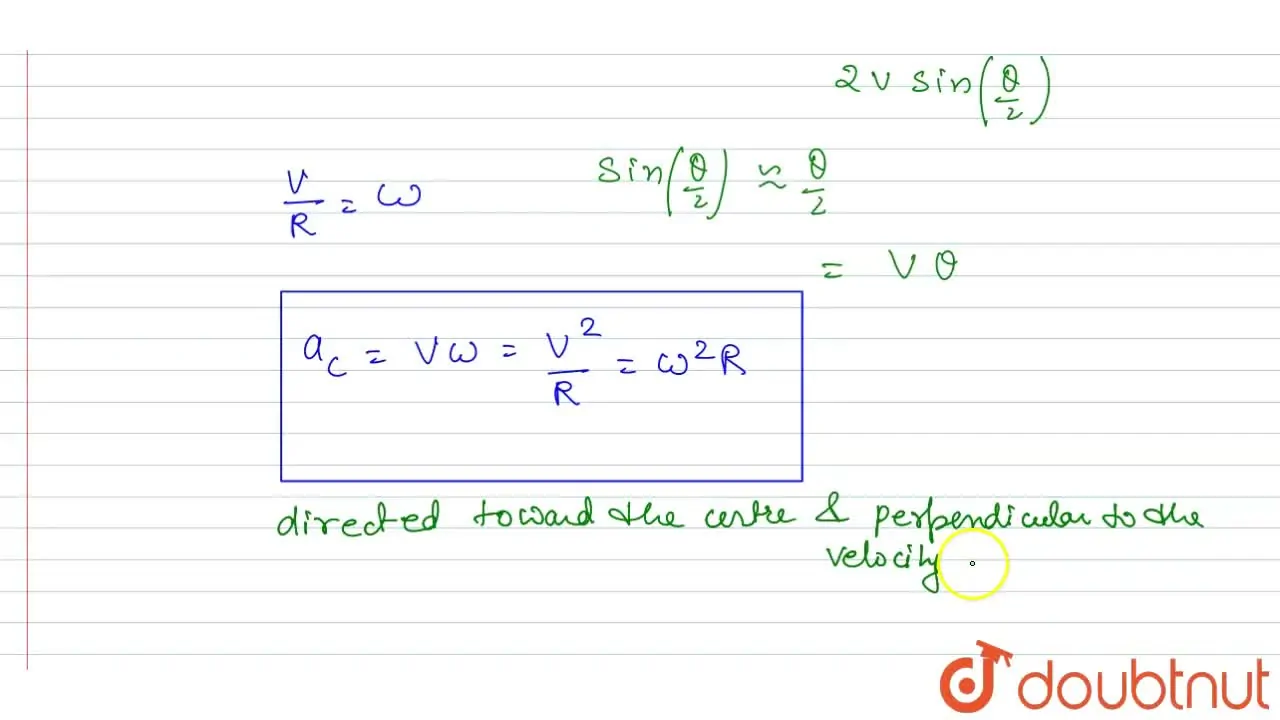What is centripetal acceleration ? Find its magniude and direction in case of a uniform circualar motion of an object .
When an object moves in a circular path with constant speed, the direction of velocity changes at every point in its path, due to which an acceleration will be produced towards the centre of the circle which is called centripetal acceleration. Let, m-mass of the particle, v-constant speed, ω uniform angular speed, r-radius of the circular path
At any time t, the particle is at P with position vector −OP=→r1 and at time t+△t the particle is at Q with position vector −OQ=→r2 such that ∠POq=△θAnga––rspeed= omega=triangletheta//triangle t " Let, "vecv_(1) and vecv_(2)arethevelocity→−−→rsofthepartic≤atPandQrespectively.<br>Sincethespeedisuniform,|vecPA|=|vecQB|=v<br>Tof∈dthechan≥∈thevelocity∈thegiventime∫erval,drawoverset(-)(P'A') and overset(-)(P'B')" as the velocity vectors "overset(-)v_(1) and overset(-)v_(2)<br>From△lawof→−−→rs:overset(-)P' A'+ overset(-)A'B'=overset(-)P'B or =overset(-)(A'B') =overset(-)(P'B')- overset(-)(P'A') =overset(-)(v_(2))-overset(-)(v_(1))=trianglevect<br>Astriangle to 0 A'B'wod––bearcofA'B'of∘≤ofradiusP'A'=v<br>therefore triangletheta=A'B'//P'A' =|trianglev|//|vecv|, omegatrignalet=|trianglevecv|//|vecv| and |trianglevecv|//|trianglevect|= |vecv|omega=(omega r)omega=omega^(2) r [v=omegar]<br>Whentrianglet to 0" then " |trianglevecv|//|trianglevect|wod––bemagnitudeofcentripηlae≤rationatPandgivenas,|veca|=|trianglevecv|//|trianglet|=omega^(2)r=(v//r)^(2)r=v^(2)//r<br>Thus,|veca|=omega^(2)=v^(2)//r<br>Thisgiventhemagnitudeoftheae≤rationofapartic≤∈uniform∘a––rmotion.<br>Directionofae≤ration:Astrianglettends→zero,the∠trianglethetaalsoapproacheszer⊙Inthislimit,asAB=AC,soangleABC=angleACB=90^(@).Thus,thechan≥∈velocitytrianglevecvandhencetheae≤rationvecaisperpendica––r→thevelocity→−−→rvecv_(1) " But "vecv_(1)isdirectedalongtan≥ntatp∮P,soae≤rationvecaactalongtheradius→wardsthecentreofthe∘≤.Suchanae≤rationiscal≤dcentripηlae≤ration.<br>Itsmagnituderema∈sconstant(=v^(2)/r) but its direction continuously changes and remains perpendicular to the velocity vector at all positions.


Related Playlists
- BOOK - VMC MODULES ENGLISHCHAPTER - Motion in Two DimensionsEXERCISE - Level -1140videos
Motion in Two Dimensions
- BOOK - VMC MODULES ENGLISHCHAPTER - Motion in Two DimensionsEXERCISE - JEE Main (Archive)19videos
Motion in Two Dimensions
- BOOK - VMC MODULES ENGLISHCHAPTER - Motion in Two DimensionsEXERCISE - MCQ2videos
Motion in Two Dimensions
- BOOK - VMC MODULES ENGLISHCHAPTER - Motion in Straight Line EXERCISE - IN-CHAPTER EXERCISE-J10videos
Motion in Straight Line
- BOOK - VMC MODULES ENGLISHCHAPTER - MOVING CHARGES & MAGNETISM EXERCISE - IN-CHAPTER EXERCISE-K10videos
MOVING CHARGES & MAGNETISM
Similar Questions
What is centripetal acceleration ? Why is it called so ?
View SolutionIn case of a uniform circular motion, velocity and acceleration are
View SolutionA particle shows uniform circular motion. Its motion is .
View SolutionIn the following questions a statement of assertion (A) is followed by a statement of reason ( R).
A : A uniform circular motion have non uniform acceleration .
R: The direction of acceleration of a particle in uniform circular motion changes continuously .View SolutionWhat name is given to the acceleration experienced by a particle in uniform circular motion?
View SolutionVelocity vector and acceleration vector in a uniform circular motion are related as
View SolutionState whether the following statements are true or false by writing T/F against them.
(a) Earth moves around Sun with a uniform velocity.
(b) The motion of moon around Earth in a circular path is an accelerated motion.
( c) A uniform linear motion is unaccelerated, while a uniform circular motion is an accelerated motion.
(d) In a uniform circular motion, the speed continuously changes because the direction of motion changes.
(e) A boy experiences a centrifugal force on his hand when he rotates a piece of stone tied at one end of a string. holding the other end in the hand.View SolutionAssertion: Centripetal acceleration is always direction towards the centre of rotation of an object undergoing uniform circular motion
Reason: Centripetal acceleration is a constant vectorView SolutionIs the acceleration of particle in uniform circular motion constant or vartiable?
View SolutionThe slope of velocity-time graph for uniform motion of an object is
View Solution


